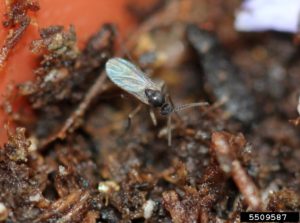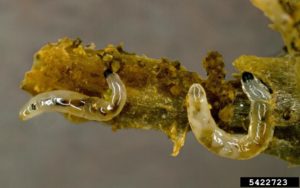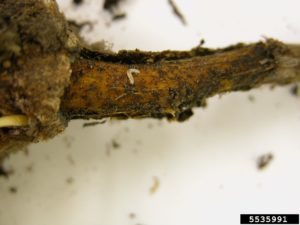When houseplants and garden seedlings are kept too wet, roots can rot and the fungus that grows in the soil can feed fungus gnats. For houseplants, fungus gnats are usually just a nuisance. When growing seedlings or in a greenhouse adults can spread fungal diseases to flowers. Larvae can spread fungal diseases when they feed on roots.

Figure 1. Adult gnats are attracted to fungus in the soil, Photo by Whitney Cranshaw, Colorado State University, Bugwood.org.

Figure 2. Eggs laid by fungus gnats hatch into long translucent maggots with black heads that thrive in moist soil.

Figure 3. When abundant, larvae will feed on plant roots and can spread disease. Photo by Penn State University Dept Plant Pathology Bugwood.org.
Where to fungus gnats come from? Fungus gnats can get in the home when plants are brought in from outside, or when transplanting plants with infested potting soil.
How do you manage fungus gnats? Avoid overwatering your plants. Plants need less water in cloudy days in winter and spring. As such, it is easy to overwater plants if you water by the calendar. It is better to check you plants to see if they need water by touching the surface to see if it is dry. After you water, do not let plants sit in a pan of water. Letting the soil dry between watering will reduce fungus and the rate of population growth. Insecticides are rarely needed for houseplants. Numerous options are available for greenhouse professionals.
Reference for Professionals
Massachusetts Greenhouse Pest Guide https://greenhousepestguide.umass.edu
This article was originally published in Purdue Extension newsletter Landscape Report